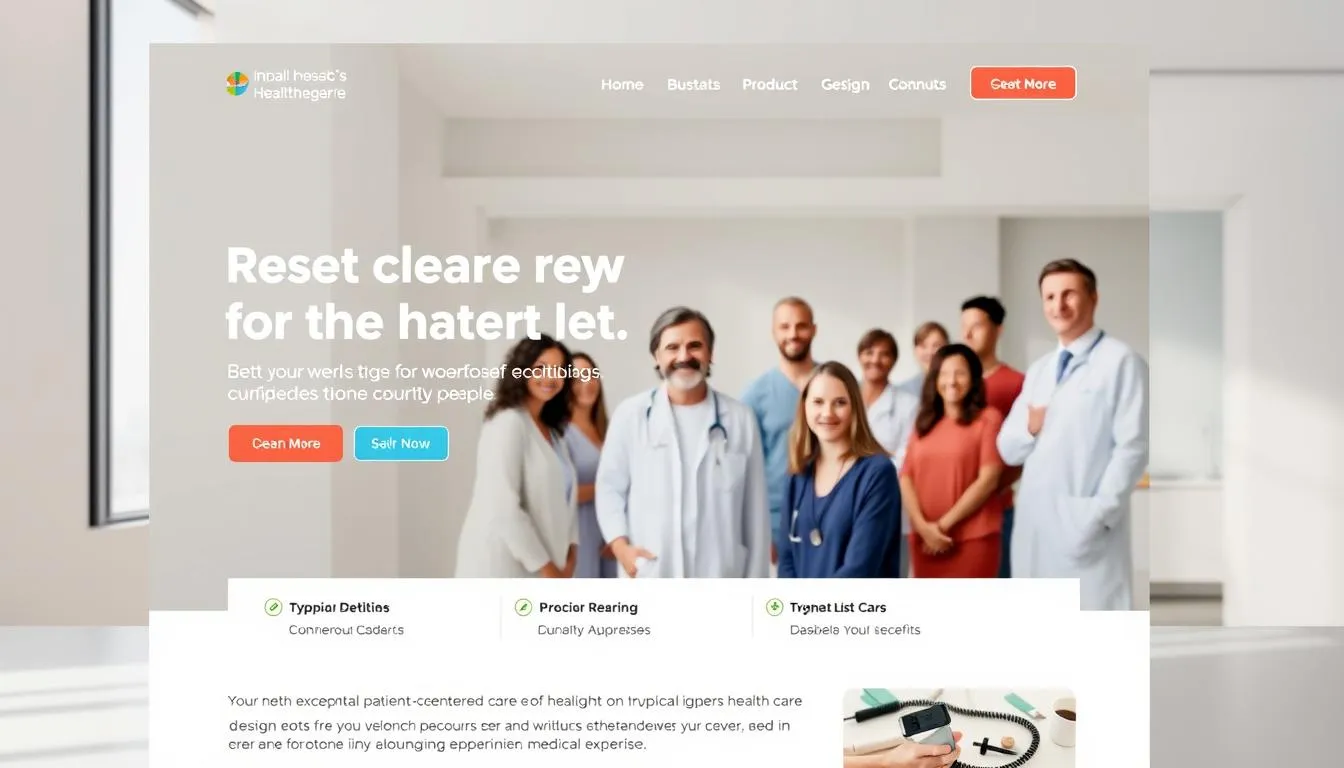Last Updated on: June 19, 2025
In today’s digital landscape, a professional and user-friendly website is crucial for healthcare providers to stand out and deliver an exceptional patient experience.
A well-designed healthcare website not only enhances patient engagement but also sets a healthcare organization apart from its competitors. Effective medical website design is key to creating a positive online presence.
With the importance of healthcare website development growing, healthcare providers must prioritize creating a website that truly serves the needs of patients and healthcare professionals alike.
Key Takeaways
- A professional website is crucial for healthcare providers.
- Effective web design enhances patient experience.
- Healthcare website development is increasingly important.
- A well-designed website sets organizations apart.
- Medical website design is key to a positive online presence.
The Critical Role of Web Design in Healthcare
The web design of a healthcare website is more than just aesthetics; it’s a critical tool for building trust and fostering patient loyalty. A well-crafted website can significantly enhance the overall user experience, making it easier for patients to find the information they need and navigate the site.
First Impressions and Trust Building
A healthcare website often serves as the first point of contact between a patient and a healthcare provider. Therefore, making a positive first impression is crucial. A clean, intuitive design can instill trust and confidence in potential patients, encouraging them to seek care. Key elements include clear navigation, professional visuals, and easily accessible information.
Patient Engagement and Retention
Effective web design can significantly boost patient engagement by providing a seamless user experience. Features such as online appointment scheduling, patient portals, and clear calls-to-action can enhance patient interaction with the website, leading to higher retention rates. By making it easy for patients to find what they need, healthcare providers can foster a loyal patient base.
Competitive Advantage in the Healthcare Market
In a competitive healthcare landscape, a superior web design can be a key differentiator. By investing in healthcare web design services, providers can stand out from competitors, attract new patients, and establish a strong brand identity. A well-designed website can also improve search engine rankings, further increasing visibility and attracting more patients.
Some key benefits of effective healthcare web design include:
- Increased patient trust and confidence
- Improved patient engagement and retention
- Enhanced competitive advantage
- Better search engine rankings
Essential Elements of Effective Healthcare Websites
In today’s digital age, a healthcare website’s effectiveness is determined by its ability to meet patient needs. Effective healthcare websites share certain essential elements that contribute to a positive user experience.
Clear Navigation and Information Architecture
A well-organized website is crucial for helping patients find the information they need quickly. This involves creating an intuitive navigation system and information architecture.
Organizing Medical Services and Specialties
Medical services and specialties should be organized in a logical and easily accessible manner. This can be achieved by using clear categories and subcategories, making it simple for patients to find the services they need.
Intuitive Patient Resource Sections
Patient resource sections should be designed to provide easy access to relevant information, such as FAQs, patient guides, and contact information. This helps patients navigate the website efficiently and find the resources they need.
Professional Visual Design and Branding
A professional visual design and branding strategy are essential for establishing trust and credibility with patients. This includes using a consistent color scheme, typography, and imagery that reflects the healthcare organization’s brand identity.
Fast Loading Speed and Performance
Ensuring that the website loads quickly and performs well across various devices is vital for maintaining patient engagement. A slow-loading website can lead to high bounce rates and negatively impact the patient experience.
What Are the Best Web Design Services for Healthcare Websites?
The best web design services for healthcare websites are those that combine industry-specific knowledge with cutting-edge design techniques. This blend is crucial for creating websites that not only attract patients but also provide a seamless user experience, ultimately driving patient engagement and retention.
Full-Service Healthcare Web Design Agencies
Full-service healthcare web design agencies offer comprehensive solutions that cater to the unique needs of healthcare organizations. These agencies typically provide a wide range of services, from initial consultation to launch and ongoing maintenance.
Benefits of Industry-Specific Expertise
One of the primary benefits of choosing a full-service agency with industry-specific expertise is their understanding of HIPAA compliant web design. This knowledge ensures that the website is designed with security and compliance in mind from the outset, reducing the risk of costly redesigns or legal issues down the line.
Cost Considerations and ROI
While cost is an important consideration, it’s essential to weigh it against the potential return on investment (ROI). A well-designed website can significantly improve patient acquisition and retention, leading to increased revenue for healthcare providers. Agencies that offer transparent pricing and ROI analysis can help organizations make informed decisions.
Specialized Healthcare UX/UI Designers
Specialized healthcare UX/UI designers focus on creating user-centered designs that enhance patient engagement. By understanding patient behaviors and preferences, these designers can craft intuitive interfaces that simplify complex healthcare information, making it more accessible to a broader audience.
Healthcare-Specific CMS Development Services
Healthcare-specific CMS development services provide flexible and secure content management solutions tailored to the healthcare industry. These services enable healthcare organizations to manage their content efficiently while maintaining the highest security standards.
WordPress Solutions for Medical Practices
For smaller healthcare providers, such as medical practices, WordPress solutions offer a user-friendly and cost-effective way to manage their website. WordPress CMS is highly customizable, allowing practices to tailor their site to their specific needs.
Custom CMS Options for Hospitals and Health Systems
Larger healthcare organizations, like hospitals and health systems, often require more complex solutions. Custom CMS options can be designed to meet the specific needs of these organizations, integrating with existing systems and workflows to enhance operational efficiency.
HIPAA Compliance and Security Considerations
HIPAA compliance and security are paramount for healthcare websites handling sensitive patient information. Ensuring the confidentiality, integrity, and availability of protected health information (PHI) is not only a legal requirement but also crucial for maintaining patient trust.
Protected Health Information (PHI) Security
Securing PHI is a critical aspect of HIPAA compliance. This involves implementing robust security measures such as encryption, secure data storage, and access controls to prevent unauthorized access or breaches. Healthcare websites must conduct regular risk assessments to identify vulnerabilities and implement mitigation strategies.
Key security measures include:
- Data encryption
- Secure authentication protocols
- Regular security audits
Secure Patient Portals and Login Systems
Patient portals are a common feature on healthcare websites, allowing patients to access their medical records, communicate with healthcare providers, and manage appointments. Ensuring these portals are secure is vital. This can be achieved through robust login systems, including multi-factor authentication, and by educating patients on password management and security best practices.
Privacy Policy and Consent Management
Healthcare websites must have clear privacy policies that inform patients how their data is collected, used, and protected. Consent management is also crucial, requiring websites to obtain explicit consent from patients before collecting or processing their PHI. Transparency and clarity in privacy policies help build patient trust.
Cookie Compliance for Healthcare Websites
Cookie compliance is an often-overlooked aspect of HIPAA compliance. Healthcare websites using cookies to track user behavior must inform patients about cookie usage and obtain consent. This involves providing clear information about cookie purposes and ensuring that cookie management complies with HIPAA regulations.
Transparent Data Collection Practices
Transparent data collection practices are essential for HIPAA compliance. Healthcare websites must clearly communicate what data is being collected, how it is used, and with whom it is shared. Patients should be given control over their data, including options to opt-out of data collection where possible.
By prioritizing HIPAA compliance and security, healthcare organizations can protect patient information, maintain trust, and avoid legal issues. Regular updates to security protocols and compliance measures are necessary to adapt to evolving threats and regulatory changes.
“The key to successful HIPAA compliance is not just about checking boxes; it’s about creating a culture of compliance and security within the organization.”
— OCR, HIPAA Compliance
Accessibility Standards for Healthcare Websites
Healthcare websites must adhere to strict accessibility standards to cater to the diverse needs of their users, including those with visual, auditory, or cognitive disabilities. Ensuring that healthcare websites are accessible is not only a legal requirement but also a moral imperative, as it enables everyone to access vital health information.
ADA Compliance Requirements
The Americans with Disabilities Act (ADA) requires that healthcare websites comply with specific accessibility guidelines. This includes making sure that the website can be navigated using assistive technologies such as screen readers. Compliance with ADA requirements involves several key aspects, including clear navigation, alternative text for images, and closed captions for multimedia content.
Inclusive Design Practices
Adopting inclusive design practices is essential for creating a healthcare website that is accessible to all users. This involves designing the website with the needs of users with disabilities in mind from the outset. Key considerations include:
- Ensuring that the website’s color scheme and layout are accessible
- Providing alternative text for medical images
- Using clear and simple language in content
Color Contrast and Readability
One crucial aspect of inclusive design is ensuring that the website has sufficient color contrast and readability. This means selecting colors for the text and background that are easily distinguishable, thereby facilitating reading for users with visual impairments.
Alternative Text for Medical Images
Providing alternative text for medical images is vital for users who rely on screen readers. This text should be descriptive and convey the essential information contained in the image, ensuring that all users can understand the content.
Assistive Technology Compatibility
Ensuring that the healthcare website is compatible with assistive technologies is critical for accessibility. This includes compatibility with screen readers, voice-to-text software, and other tools that users with disabilities may rely on to navigate the web.
The following table summarizes key accessibility features and their benefits:
User Experience Optimization for Patient Engagement
A well-designed user experience is essential for fostering patient engagement in the healthcare sector. By optimizing various elements of their websites, healthcare providers can significantly enhance patient interaction and overall satisfaction.
Intuitive Appointment Scheduling Systems
One of the critical aspects of user experience optimization is the implementation of intuitive appointment scheduling systems. These systems allow patients to easily book, reschedule, or cancel appointments online, reducing the administrative burden on healthcare staff and improving patient satisfaction.
Key features of effective appointment scheduling systems include:
- Clear and simple navigation
- Real-time availability
- Reminders and notifications
- Integration with existing patient records systems
Patient Resources and Educational Content
Providing valuable patient resources and educational content is another vital aspect of enhancing patient engagement. By offering relevant and easily accessible information, healthcare providers can empower patients to take a more active role in their healthcare.
Examples of effective patient resources include:
- Detailed information about medical conditions and treatments
- Health tips and wellness advice
- Access to interactive health tools and calculators
- Video content explaining medical procedures
Interactive Health Tools and Calculators
Interactive health tools and calculators can help patients understand their health better and make informed decisions. These tools can range from simple BMI calculators to complex symptom checkers.
Video Content for Medical Procedures
Video content explaining medical procedures can significantly improve patient understanding and reduce anxiety. By visually explaining complex procedures, healthcare providers can better prepare patients for what to expect.
Feedback Collection and Implementation
Collecting and implementing patient feedback is crucial for continuously improving the website and overall patient experience. Healthcare providers should implement mechanisms for patients to provide feedback on their experience and suggestions for improvement.
By actively seeking and responding to patient feedback, healthcare providers can demonstrate their commitment to patient-centered care, further enhancing patient engagement and trust.
Mobile-First Design for Healthcare Websites
In today’s digital landscape, a mobile-first design strategy is crucial for healthcare websites to cater to the growing number of mobile users. With the majority of patients now accessing healthcare services online through their mobile devices, adopting a mobile-first approach is no longer optional but essential for providing an optimal user experience.
Responsive Design Best Practices
Implementing responsive design best practices is fundamental to ensuring that healthcare websites adapt seamlessly to various screen sizes and devices. This involves using flexible grids, images, and media queries to create a consistent and user-friendly experience across different platforms.
Mobile-Friendly Features for Patients On-the-Go
Healthcare websites should incorporate mobile-friendly features that cater to the needs of patients on-the-go. This includes features that enhance usability and accessibility.
Click-to-Call Functionality
One such feature is click-to-call functionality, which allows patients to quickly contact healthcare providers with a single tap, enhancing the overall user experience and facilitating communication.
Mobile Maps and Directions
Another valuable feature is mobile maps and directions, which help patients navigate to healthcare facilities easily, reducing the likelihood of missed appointments due to navigation issues.
Performance Optimization for Mobile Devices
Optimizing the performance of healthcare websites for mobile devices is critical to ensure that they load quickly and remain accessible. This involves optimizing images, leveraging browser caching, and minimizing the use of heavy scripts to improve page load times.
Measuring Success: Analytics and Improvement
Effective healthcare website management relies heavily on data-driven insights to drive continuous improvement. To achieve this, healthcare organizations must implement a robust analytics system that tracks key performance indicators and analyzes the patient journey.
Key Performance Indicators for Healthcare Websites
Key performance indicators (KPIs) are essential metrics that help healthcare organizations evaluate the success of their website. These may include website traffic, patient engagement metrics, and conversion rates. By monitoring these KPIs, healthcare providers can identify areas for improvement and optimize their website accordingly.
Patient Journey Tracking and Analysis
Understanding the patient journey is critical to improving the overall user experience. By tracking how patients interact with the website, healthcare organizations can identify pain points and areas where patients may be dropping off. This information can be used to refine the website and improve patient engagement.
Continuous Improvement Strategies
Continuous improvement is vital to ensuring that a healthcare website remains effective over time. Strategies may include A/B testing and incorporating user feedback.
A/B Testing for Healthcare Websites
A/B testing involves comparing two versions of a webpage to determine which one performs better. This can help healthcare organizations refine their website and improve patient engagement.
User Feedback Implementation
Incorporating user feedback is another crucial aspect of continuous improvement. By listening to patient concerns and suggestions, healthcare organizations can make targeted improvements to their website, enhancing the overall user experience.
Conclusion: Investing in Quality Healthcare Web Design
Investing in quality healthcare web design is a crucial step for healthcare organizations seeking to enhance patient engagement and stay competitive in the market. By understanding the importance of web design and selecting the right healthcare web design services, healthcare providers can create exceptional websites.
A well-designed website is an invaluable asset, serving as a foundational element in their digital presence and patient care strategy. Prioritizing aspects such as HIPAA compliance, accessibility, and user experience optimization is essential for quality healthcare websites.
By investing in healthcare web design, healthcare organizations can improve the user experience, increase patient satisfaction, and ultimately drive business growth. Effective healthcare web design services can help organizations achieve their goals and establish a strong online presence.
FAQ
What is the importance of having a professional website for healthcare providers?
Having a professional and user-friendly website is crucial for healthcare providers as it enhances the patient experience, sets the organization apart from competitors, and provides a platform for patients to access information and services.
How does web design impact patient engagement and retention?
A well-designed website can significantly enhance patient engagement and retention by providing an intuitive user experience, making it easier for patients to find the information they need, and fostering trust through a professional visual design and branding strategy.
What are the essential elements of effective healthcare websites?
Effective healthcare websites share certain essential elements, including clear navigation and information architecture, professional visual design and branding, and fast loading speed and performance, all of which contribute to a positive user experience.
What are the best web design services for healthcare websites?
The best web design services for healthcare websites include full-service healthcare web design agencies, specialized healthcare UX/UI designers, and healthcare-specific CMS development services, such as WordPress solutions for medical practices and custom CMS options for hospitals and health systems.
How can healthcare organizations ensure HIPAA compliance and security on their websites?
Ensuring HIPAA compliance and maintaining website security involves implementing robust measures to protect PHI, securing patient portals and login systems, managing privacy policies and consent, and complying with cookie regulations.
What are the accessibility standards for healthcare websites?
Healthcare websites must comply with ADA requirements, adopt inclusive design practices, ensure color contrast and readability, provide alternative text for medical images, and ensure compatibility with assistive technologies to ensure accessibility for all users.
How can healthcare websites optimize user experience for patient engagement?
Optimizing user experience involves implementing intuitive appointment scheduling systems, providing valuable patient resources and educational content, collecting and implementing patient feedback, and incorporating interactive health tools and calculators and video content.
Why is a mobile-first design approach important for healthcare websites?
A mobile-first design approach is crucial as the majority of internet users access websites through mobile devices, and a responsive design ensures that the website adapts seamlessly to various screen sizes, enhancing the user experience for patients on-the-go.
How can healthcare organizations measure the success of their website?
Measuring success involves tracking key performance indicators, analyzing the patient journey, and implementing continuous improvement strategies, such as A/B testing and incorporating user feedback, to refine the website over time.
What is the role of analytics in improving healthcare website performance?
Analytics play a critical role in understanding how patients interact with the website, highlighting areas for improvement, and informing continuous improvement strategies to enhance the user experience and improve patient engagement.




